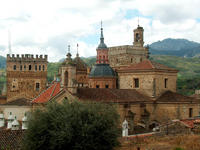You are in: Europe -> Spain -> Royal Monastery of S... , and traditional search or Image Gallery will yield results of this site only
Royal Monastery of Santa María de Guadalupe
| Site number: | 665 |
|
| Type of site: | Cultural | |
| Date: | 1492 | |
| Date of Inscription: | 1993 | |
| Location: | Europe, Spain, Province of Cáceres, Autonomous Community of Extremadura | |
Up to 75 images are shown here. Click on each for more details or on Image Gallery for more images.
| Description: | The monastery marvelously stores four centuries worth of Spanish religious architecture. It represents two major world history events that transpired in 1492: the Catholic Kings Reconquest of the Iberian Peninsula and the arrival of Christopher Columbus in the Americas. Its well-known statue of the Virgin grew to be a powerful representation of the Christianization of a good deal of the New World. --WHMNet paraphrase from the description at WHC Site, where additional information is available. | |
| The Royal Monastery of Santa Maria de Guadalupe (Spanish: Real Monasterio de Nuestra Señora de Guadalupe) is a monastic establishment in Guadalupe, Cáceres province of the Extremadura autonomous community of Spain; it was the most important monastery in the country for more than four centuries. It is protected by the UNESCO as a World Heritage Site. The monastery, whose architecture evolved throughout many centuries, is still dominated by the templo mayor, or the main church, built by Alfonso XI and his immediate successors in the 14th and 15th centuries. The square chapel of Santa Catalina is also of the 15th century;it is known for a cluster of ornate 17th-century tombs. The 16th-century reliquaries chapel connects Santa Catalina with the baroque sacristy(1638-47), lavishly decorated and boasting a series of paintings by Zurbaran. Behind the basilica is Camarin de la Virgen, an octagonal baroque structure(1687-96)with the impressive stuccoed Chamber of the Virgin and nine paintings by Luca Giordano. The jewel of this profusely ornamented hall is a throne containing the statue of Madonna which gave the monastery its name. Other notable structures include the Mudéjar cloister (1389-1405), with the magnificent Plateresque portal; the late Gothic cloister from 1531-33, and the new church, commissioned by one of Columbus's descendants in 1730. Regrettably, the palace of Isabella of Castile (1487-91) was pulled down in 1856. The monastery had its origins in the late 13th century, when a shepherd from Cáceres, named Gil Cordero, discovered on the bank of the Guadalupe River a statue of Madonna, which had been apparently hidden by local inhabitants from Moorish invaders in 714. On the site of his discovery a chapel was built. King Alfonso XI, who visited the chapel more than once, invoked Santa Maria de Guadalupe in the Battle of Rio Salado. After gaining the victory, he ascribed it to the Madonna's intercession, declared the church at Guadalupe a royal sanctuary and undertook an extensive rebuilding program. In 1389, the Hieronymite monks took over the monastery and made it their principal house. Construction works continued under the auspices of the order's first prior, and in 1474 Henry IV of Castile was entombed in Guadalupe, next to his mother. The monastery is rich in associations with the New World, where Our Lady of Guadalupe is highly revered in the Mexican Basilica of Guadalupe and elsewhere. It was here, in Extremadura, that Christopher Columbus made his first pilgrimage after discovering America in 1492 and it was here that he first thanked heaven for his discovery. --Wikipedia. Text is available under the Creative Commons Attribution-ShareAlike License. | ||
| Source: | http://whc.unesco.org/en/list/665 | |
| Reference: | 1. UNESCO World Heritage Center, Site Page. | |







